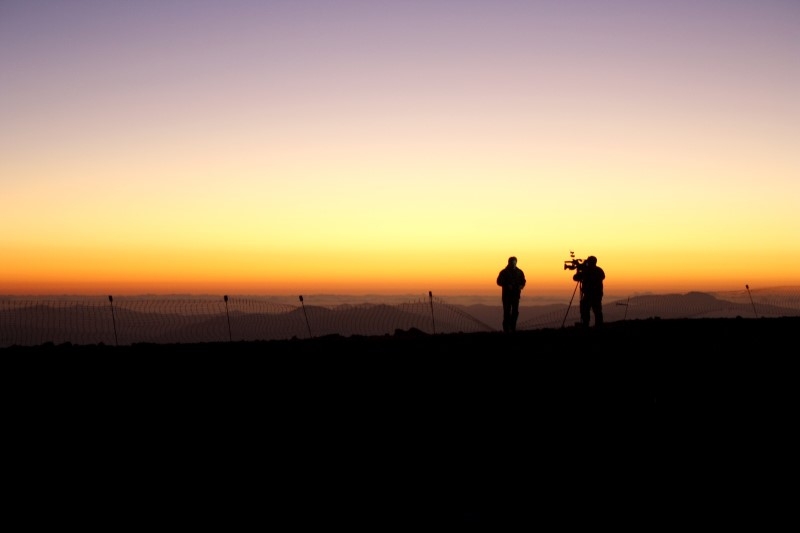- Home
- Science
- Science News
- Hoping to Find Life on Other Planets, Astronomers Start on Giant Chile Telescope
Hoping to Find Life on Other Planets, Astronomers Start on Giant Chile Telescope

The Giant Magellan Telescope (GMT), scheduled to be completed by 2024, will have a resolution 10 times that of the Hubble spacecraft. Experts say it will be able to observe black holes in the distant cosmos and make out planets in other solar systems with unprecedented detail.
Such technology, astronomers say, will help humans determine how the universe formed and if planets hundreds of light years away could support life.
"With this science, there are no limits to the possibilities that are open," said Bachelet, standing on the GMT's site, a wind-buffeted, 8,250-foot (2,500-metre) mountaintop.
"What it does is open the door to understanding," she said.
The GMT - a collaboration of institutions in the United States, Chile, South Korea, Brazil, and Australia - will rely on seven intricately curved lenses, each almost 28 feet (8.5 meters) wide.
For the system to work, no one lens can have a blemish of more than 25 nanometers, which is some four thousand times smaller than the average width of a human hair.
"Astronomy is like archaeology; what we see in the sky happened many years ago," said Yuri Beletsky, a Belarussian astronomer for the GMT. "The biggest expectation is that we find something that we don't expect," he added on a bus driving up sinuous switchbacks to the planned observatory.
Two other massive instruments - the European Extremely Large Telescope, also in Chile, and the Thirty Meter Telescope in Hawaii - are scheduled to be completed in the 2020s as well. But GMT President Patrick McCarthy says the telescope's massive single lenses and wider observation field will allow for more precise measurements.
Among the phenomena he hopes to observe is dark matter, mysterious invisible material that makes up most of the universe's mass.
Astronomers say Chile's bone-dry Atacama Desert, host to the GMT and dozens of other high-powered telescopes, is uniquely suited to space observation as it has dry air, high mountains, and little light pollution.
McCarthy also points out that another advantage for astronomers in Chile is that the airflow from the nearby Pacific Ocean is smoother than that over continental deserts, meaning scientists have to contend with less atmospheric interference.© Thomson Reuters 2015
Catch the latest from the Consumer Electronics Show on Gadgets 360, at our CES 2026 hub.
Related Stories
- Samsung Galaxy Unpacked 2025
- ChatGPT
- Redmi Note 14 Pro+
- iPhone 16
- Apple Vision Pro
- Oneplus 12
- OnePlus Nord CE 3 Lite 5G
- iPhone 13
- Xiaomi 14 Pro
- Oppo Find N3
- Tecno Spark Go (2023)
- Realme V30
- Best Phones Under 25000
- Samsung Galaxy S24 Series
- Cryptocurrency
- iQoo 12
- Samsung Galaxy S24 Ultra
- Giottus
- Samsung Galaxy Z Flip 5
- Apple 'Scary Fast'
- Housefull 5
- GoPro Hero 12 Black Review
- Invincible Season 2
- JioGlass
- HD Ready TV
- Laptop Under 50000
- Smartwatch Under 10000
- Latest Mobile Phones
- Compare Phones
- Honor Win RT
- Honor Win
- Xiaomi 17 Ultra Leica Edition
- Xiaomi 17 Ultra
- Huawei Nova 15
- Huawei Nova 15 Pro
- Huawei Nova 15 Ultra
- OnePlus 15R
- Asus ProArt P16
- MacBook Pro 14-inch (M5, 2025)
- OPPO Pad Air 5
- Huawei MatePad 11.5 (2026)
- Xiaomi Watch 5
- Huawei Watch 10th Anniversary Edition
- Acerpure Nitro Z Series 100-inch QLED TV
- Samsung 43 Inch LED Ultra HD (4K) Smart TV (UA43UE81AFULXL)
- Asus ROG Ally
- Nintendo Switch Lite
- Haier 1.6 Ton 5 Star Inverter Split AC (HSU19G-MZAID5BN-INV)
- Haier 1.6 Ton 5 Star Inverter Split AC (HSU19G-MZAIM5BN-INV)

















